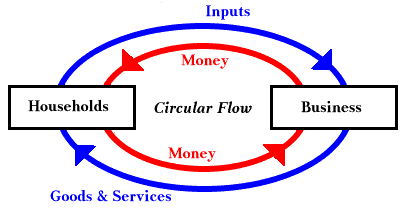

The circular flow diagram illustrates the equivalence of the income approach and expenditures.goodrx mupirocin 2% ointmentĬircular Flow Diagram beserta penjelasannya Studiekonomi…

How are businesses involved in this flow? Businesses sell goods and services in product markets. These resources are then used to produce goods and services sold in product markets. WebIn a circular flow diagram, labor and other factors of production are sold in resource markets. To Treat COVID-19’s Economic Impact, Start by Keeping the …Įconomics Quiz 1.docx - End of Week 1 Quiz 1. In order for economies to thrive, there …Įconomic Circular Flow Teaching Resources TPT circular flow of ecnomic questions The circular flow model in economics describes how resources, money, goods, and services flow through an economy.It illustrates the interactions of economic participants in each of the markets, as well as how the flow of payments … chest pain and right arm ache In a circular-flow diagram, which economic player provides labor … WebThe circular flow model is at the heart of economic activity. It is often represented with a circular flow model like the one seen …

It can be estimated using one of three methods: looking at total expenditure, at total income or using the production approach.Circular flow of economic WebThe circular flow of the economy is used to explain the relationship between money and goods and services.

The way of measuring all these flows of money is the gross domestic product (GDP). However, this diagram introduces a clear view of how the economy works. Things such as government spending (in the form of unemployment benefits, for example) or government income ( taxes) are not shown in the diagram. For instance, take government intervention. There are a few things that are not showed in this diagram that must be taken into account to really understand how the economy of a country works. It’s worth mentioning that, as usually, diagrams do not shown how the economy actually works. The exchanges made in the economy imply a redistribution of rent according to the diagram, and the creation of value makes the economy grow. When we combine both diagrams, we get the circular-flow diagram, as shown below. Factors of production flow form households (red arrow) to firms, so they can produce more goods and services. In this case, money flows from firms to households (green arrow in the diagram below) in the form of wages in exchange for labour, interests for capital and rent for the use of land. Firms use these factors in their production. The market for factors of production is the place where households offer their labour, capital and other factors such as land, receiving an income for their use. In this case, the flow of money (green arrow in the diagram below) goes from households to firms, in exchange for finished products, which flow from firms to households (red arrow). This market represents the place where money and goods are exchanged. In other words, is the place where firms sell the goods and services they have produced, receiving a revenue paid by households. The market for goods and services is the place where households spend their money buying goods and services produced by firms. market for factors of production (such as labour or capital), where firms purchase factors of production from households in exchange for money. market for goods and services, where households purchase goods and services from firms in exchange for money The circular-flow diagram (or circular-flow model) is a graphical representation of the flows of goods and money between two distinct parts of the economy:


 0 kommentar(er)
0 kommentar(er)
